GARDEN STYLES
Gardens come in all types of styles: formal and informal, natural and contrived. Styles have evolved differently in different countries; 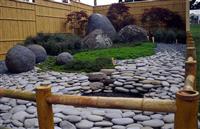 with some styles reflecting cultural attitudes and values, or historical developments. Sometimes when countries were invaded the invading forces brought plant species, construction techniques and design ideas with them. When social attitudes were structured, garden design became structured; and when social attitudes became revolutionary, sometimes garden styles reflected those attitudes with great change.
with some styles reflecting cultural attitudes and values, or historical developments. Sometimes when countries were invaded the invading forces brought plant species, construction techniques and design ideas with them. When social attitudes were structured, garden design became structured; and when social attitudes became revolutionary, sometimes garden styles reflected those attitudes with great change.
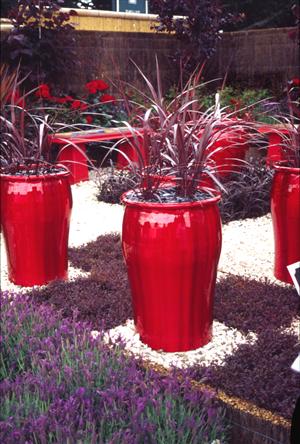 See Below:
See Below:
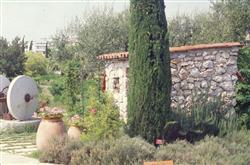
MEDITERRANEAN GARDENS
Think of Mediterranean gardens, and your mind probably conjures images of blue skies, sun-baked courtyards, and long, lazy lunches under vine-covered pergolas. In every good Mediterranean garden design the key ingredients are light, warmth, simplicity and relaxation. The features of a Mediterranean garden can be diverse, but the one thing they don’t include is modern components (such as modern sculpture/furniture).
A symmetrical design is often found in old southern European gardens, but with modern use of these gardens, things have occasionally been introduced that breaks that rigid symmetry.
Because many Mediterranean gardens are in a confined area, a central axis is often included in the design. This increases the apparent size of the garden by maintaining the one long vista. The eye is drawn along that vista, and as you walk along, features are revealed to either side. As plants grow and obscure sections of the garden, the sense of unfolding surprise is increased.
The main hard landscape materials are stone, concrete and ceramics – these durable, earthy materials are used in abundance. Timber is also occasionally used (usually for constructing pergolas and sturdy outdoor tables and benches). Metal is rarely used – generally restricted to decorative cast iron lacework. The only use of plastics is likely to be lightweight pots in ceramic colours.
The predominant colours have a sun-bleached look – white, or earthy shades such as terracotta and sandstone are popular. Splashes of bright colours such as brilliant blues are used for contrast. (This also reminds the viewer of the brilliant blue of the Mediterranean Sea.)
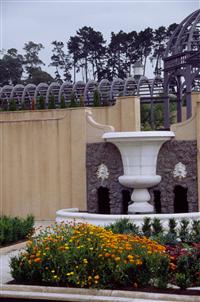
Typically these gardens don’t have lawns (or only small patches of lawn).Lawns need lots of water in summer, which is the driest time of year in most Mediterranean climates.Instead ground surfaces are paved or covered with gravel.
Walled gardens and courtyards are popular. They create warm, sheltered and intimate spaces for relaxing and entertaining.
Overhead shade is a necessity – usually provided by pergolas and verandas.
Outdoor furniture is essential for relaxing – for a rustic look use long timber tables and benches; in more formal settings, metal furniture may be preferred.
Water features are usually simple, often used for their cooling effect – swimming pools, fountains or ponds rather than watercourses or cascades.
Terracing is used on larger, sloping blocks.
Garden ornaments are either traditional and/or rustic. Examples include olive jars and traditional statues
Plants tend to be secondary to the hard landscaping. They are hardy and drought tolerant, often with silver-grey foliage typical of drier climates. Many occur naturally in the Mediterranean, or have been grown in the area for thousands of years, eg. Lavender, Olive, Roses, Rosemary, Pencil Pines.
Container plants are popular, including window boxes with geraniums and large tubs or barrels planted with citrus or olives.
Topiary and other pruning techniques can add to the formal elements of a Mediterranean garden.
Splashes of bold colour are sometimes used – but not always. The preferred uses of bold colour are colourful tiles or bright painted walls, mosaics and tromp l’oeil – these should not be excessive.
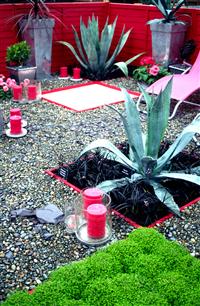
ECLECTIC GARDENS
Eclectic means “a mixture of styles". The freedom to mix styles gives an eclectic designer great freedom; but with that freedom comes a huge risk. When you create an eclectic garden, you are largely working outside the ‘normal’ rules that govern the way a garden might be created.
Eclectic gardens tend to combine many different styles of gardening. Using a creative approach, designers take their inspirations from all the garden traditions, combining plants, garden accessories and outdoor artworks to create distinctive and highly individual landscapes. The trick is to combine the components carefully and not to go overboard with excessive contrasts. Excessive contrasts may end up as confusing, jumbled mess, so that no one feature stands out.
For example, when designing a formal garden, lines are clean, and there is a symmetrical balance between the features in the garden. With a naturalistic garden, you are aiming to do the opposite – that is, you are avoiding symmetrical balance and hard, clean lines. In an eclectic garden, however, you are attempting to mix styles and avoiding any one particular style becoming dominant.
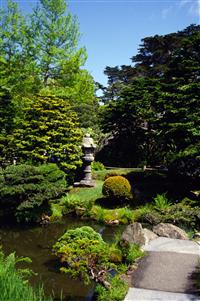
ORIENTAL GARDENS
Oriental gardens are gardens with a purpose.
They are gardens filled with symbolism; they attempt to create a peaceful ambience, often through simplicity of design. They frequently avoid clutter, and consciously avoid using an excessive variety of materials. The number of plant varieties is often limited. Cultivars are often planted in mass, to create an effect. A courtyard may contain an area of gravel with only one or a few rocks – the effect is more dramatic when the number of rocks is limited.
Oriental gardens strive to create harmony and balance, often by imitating nature but rarely through the use of symmetry in the design. As a person moves through an Oriental garden, a series of “pictures” or “images” should unfold. For this reason it is important that the design creates a sense of enclosure.
In a western garden, we think of creating the hard landscape, then adding the plants. But in Oriental gardening, the plants and hard landscape components are thought of as inseparable. Natural components such as rock, water, timber and sand or gravel are important, but may often be used in a stylised or symbolic way.
The style of Oriental gardens has been maintained for centuries. Consequently they tend to be timeless and free of fads and styles. Australian gardeners can learn a great deal about the principles of garden design through a study of Oriental gardens.
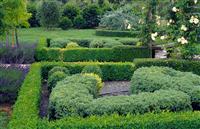
FORMAL GARDENS
Formal Garden Style is smart and stylish. It has been developed over many centuries and is still popular in today’s gardens.
The main features of formal gardens are strong lines and geometric shapes, usually set within a framework of hedges, paths and paving. The gardens can be simple or lavish, large or small and surround a traditional or modern house. They can incorporate the entire garden or just a small, separate area within the garden.
Strictly speaking, a formal garden follows a geometric design, where shapes and lines are duplicated on either side of an imaginary line. In a broader sense, any garden made up of uniform plantings and with a strong layout is called a ‘formal’ garden.
You may also be interested in....